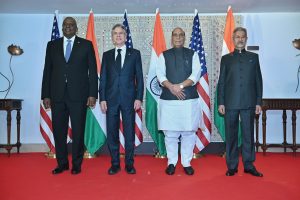India and the U.S. held their 2+2 annual strategic dialogue on November 10. U.S. Secretary of State Antony J. Blinken and Secretary of Defense Lloyd J. Austin were in New Delhi for the fifth iteration of the ministerial dialogue that began in 2018. The Indian side was led by Minister of External Affairs Dr. S. Jaishankar and Defense Minister Rajnath Singh.
There were several noteworthy features of this edition of the dialogue, the most important of which was that the it was held at all. The India-U.S. partnership has been steadily deepening, but nevertheless, both sides are currently preoccupied with multiple other crises.
The United States has its hands full with the war in Gaza, as well as with the continuing war in Ukraine. On Gaza, there appears to be broad agreement between India and the United States. Indian Prime Minister Narendra Modi was among the earliest to criticize the horrendous Hamas terrorist attack on Israel in which more than 1,200 people were killed; Hamas took more than 200 hostages amid the initial attack. The U.S. similarly has strongly supported Israel despite significant dissent from the left wing of Biden’s Democratic Party. Both the United States and India, nevertheless, also support Palestinian civilians in Gaza caught up in the conflict, as Israel relentlessly pursues Hamas’ destruction.
At the same time, India and the U.S. do have disagreements over the Russian invasion of Ukraine, with the U.S. continuing to strongly support Ukraine, while India has refused to condemn the Russian invasion. Despite significant amount of Western support, Ukraine’s most recent offensive appears to have ground to a halt without significant achievements. This suggests that the war will continue for some time, possibly even past next year’s U.S. presidential elections.
Despite such areas of disagreement, New Delhi and Washington have found a way to put such issues aside and continue to deepen their strategic cooperation. But more important than agreements and disagreements on these multiple crises is the fact that they have not allowed these other immediate and pressing crises to derail or even delay India-U.S. strategic ties.
For both countries, the strategic challenge posed by a belligerent China to their respective national interests as well as the broader regional dynamics in the Indo-Pacific has been loud and clear. Even though the joint statement issued by the two sides did not mention China by name, Singh did not mince words at the press briefing when he stated that India and the United States are on the same page regarding strategic issues “including countering China’s aggression.” Although the defense minister’s statement was unusual in his bluntness, and may have come out stronger than he intended, it is noteworthy that there was no subsequent correction or explanation to dilute the statement. The two sides also reiterated their steadfast commitment to ensuring a free, open and inclusive Indo-Pacific including through partnerships such as the Quad.
Bilateral defense cooperation, strengthened collaboration on outer space issues, and semiconductors were among some of the other substantial aspects of the 2+2 Dialogue. The ministers took note of the progress being made in the defense arena, especially “the commencement of negotiations for a commercial agreement between General Electric (GE) Aerospace and Hindustan Aeronautics Limited (HAL) to manufacture GE F-414 jet engines in India.” The ministers added that this is the kind of partnership that they look forward to developing as they look for additional areas of co-production and co-development of defense systems.
Speaking to a small group of journalists, Austin said, “Today, we agreed to move forward with the co-production of armored infantry vehicles. We also discussed steps that we can take to strengthen our supply chain security and integrate the provision of goods and services from U.S. and Indian firms.” Further, India is also planning to buy 31 MQ-9B armed drones from the U.S. at a cost of around $3 billion with the goal of enhancing the overall surveillance at the China-India border areas and the Indian Ocean region.
Space collaborations are also being augmented, with the two sides joining hands to establish a fifth sub-working group with a focus on “space commerce,” under the India-U.S. Civil Space Joint Working Group. The working group is led by NASA and ISRO, the space agencies of the U.S. and India, respectively. The two sides also appreciated the addition of “planetary defense” as a topic under the working group, as well as news of India’s joining the multilateral Space Mission Planning Advisory Group (SMPAG) and International Asteroid Warning Network (IAWN) by the end of 2023.
The joint statement highlighted the interest on both sides in enhancing “investment in India’s growing maintenance, repair and overhaul (MRO) sector, which encompasses aircraft maintenance and mid-voyage repair of U.S. naval vessels. They welcomed commitments from the U.S. industry to further increase India’s MRO capabilities, including for the repair of aircraft and unmanned aerial vehicles.”
There is understandable concern that multiple global crises will divert American attention away from the Indo-Pacific, but the India-U.S. 2+2 strategic dialogue suggests that while the U.S. is no doubt preoccupied with both Europe and the Middle East, it has not entirely lost sight of what needs to be done in the Indo-Pacific.

































